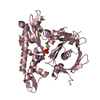+Search query
-Structure paper
| Title | The structure of a 15-stranded actin-like filament from Clostridium botulinum. |
|---|---|
| Journal, issue, pages | Nat Commun, Vol. 10, Issue 1, Page 2856, Year 2019 |
| Publish date | Jun 28, 2019 |
 Authors Authors | Fujiet Koh / Akihiro Narita / Lin Jie Lee / Kotaro Tanaka / Yong Zi Tan / Venkata P Dandey / David Popp / Robert C Robinson /     |
| PubMed Abstract | Microfilaments (actin) and microtubules represent the extremes in eukaryotic cytoskeleton cross-sectional dimensions, raising the question of whether filament architectures are limited by protein ...Microfilaments (actin) and microtubules represent the extremes in eukaryotic cytoskeleton cross-sectional dimensions, raising the question of whether filament architectures are limited by protein fold. Here, we report the cryoelectron microscopy structure of a complex filament formed from 15 protofilaments of an actin-like protein. This actin-like ParM is encoded on the large pCBH Clostridium botulinum plasmid. In cross-section, the ~26 nm diameter filament comprises a central helical protofilament surrounded by intermediate and outer layers of six and eight twisted protofilaments, respectively. Alternating polarity of the layers allows for similar lateral contacts between each layer. This filament design is stiffer than the actin filament, and has likely been selected for during evolution to move large cargos. The comparable sizes of microtubule and pCBH ParM filaments indicate that larger filament architectures are not limited by the protomer fold. Instead, function appears to have been the evolutionary driving force to produce broad, complex filaments. |
 External links External links |  Nat Commun / Nat Commun /  PubMed:31253774 / PubMed:31253774 /  PubMed Central PubMed Central |
| Methods | EM (helical sym.) / X-ray diffraction |
| Resolution | 3.253 - 4.7 Å |
| Structure data | EMDB-9757: pCBH ParM filament EMDB-9758: pCBH ParM filament  PDB-6ixw: |
| Chemicals |  ChemComp-ADP:  ChemComp-MG: |
| Source |
|
 Keywords Keywords | STRUCTURAL PROTEIN / Actin ParM / PROTEIN FIBRIL / ParM / filaments / cytoskeleton |
 Movie
Movie Controller
Controller Structure viewers
Structure viewers About Yorodumi Papers
About Yorodumi Papers







 Clostridium botulinum F str. 230613 (bacteria)
Clostridium botulinum F str. 230613 (bacteria)